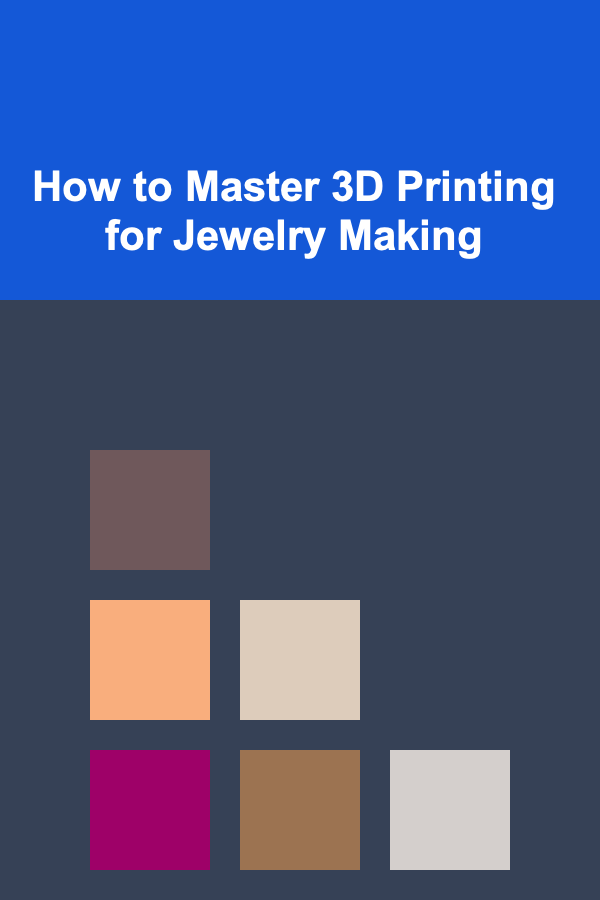
How to Master 3D Printing for Jewelry Making
ebook include PDF & Audio bundle (Micro Guide)
$12.99$6.99
Limited Time Offer! Order within the next:

3D printing has revolutionized many industries, and jewelry making is no exception. The ability to rapidly create detailed and intricate designs without the need for traditional methods like casting or handcrafting has changed the way jewelers approach their work. With the advent of 3D printing, designers and jewelers can now bring their ideas to life in ways that were previously unimaginable.
This article will guide you through the process of mastering 3D printing for jewelry making. We will explore the different types of 3D printing technologies available, the materials used in jewelry printing, the steps involved in designing and printing jewelry pieces, and the challenges you may face along the way. By the end of this article, you will have a comprehensive understanding of how to incorporate 3D printing into your jewelry-making process, enhancing both your creativity and your efficiency.
Understanding 3D Printing Technologies for Jewelry Making
Fused Deposition Modeling (FDM)
Fused Deposition Modeling (FDM) is one of the most common 3D printing technologies. In FDM, a filament material is heated and extruded layer by layer to build up a three-dimensional object. While FDM can be used for some jewelry prototypes, it's generally not the best option for creating high-detail jewelry pieces due to the layer lines and rough surface finish. However, it is an affordable option for prototyping and testing basic designs.
Stereolithography (SLA)
Stereolithography (SLA) is another 3D printing technology that uses a liquid resin that is cured layer by layer with a UV light source. SLA printing is highly accurate, making it an excellent choice for jewelry makers looking for fine detail and smooth surface finishes. The fine resolution makes it ideal for producing intricate designs, including gemstone settings, filigree, and other delicate features. However, the resin used in SLA printers may require post-processing steps such as cleaning, curing, and support removal.
Digital Light Processing (DLP)
Similar to SLA, Digital Light Processing (DLP) is a form of 3D printing that uses a light source to cure a liquid resin. The key difference is that DLP uses a digital projector to flash an entire layer of the object at once, rather than a laser tracing the shape. This results in faster printing speeds compared to SLA. Like SLA, DLP is excellent for high-precision jewelry making and is ideal for creating highly detailed and small-scale designs.
Selective Laser Sintering (SLS)
Selective Laser Sintering (SLS) is a 3D printing technology that uses a laser to sinter powdered material, such as nylon, into a solid object. SLS printers do not require support structures, as the surrounding powder provides natural support during the printing process. While SLS is primarily used for functional parts, it is also capable of producing jewelry pieces, especially those made from metals such as titanium, gold, or silver. This method is ideal for jewelry makers who wish to print directly in metal without the need for casting.
Binder Jetting
Binder Jetting is a method of 3D printing that involves spraying a liquid binder onto a powder bed, which fuses the powder together. After each layer is printed, the bed is lowered, and another layer of powder is spread. This process repeats until the object is fully printed. Binder jetting can be used for printing jewelry pieces in precious metals and can produce intricate designs. The printed pieces usually require post-processing, such as sintering and polishing.
Metal 3D Printing
For jewelry making, metal 3D printing is one of the most advanced techniques. Technologies such as Direct Metal Laser Sintering (DMLS) or Electron Beam Melting (EBM) can be used to print jewelry directly in precious metals like gold, platinum, and silver. These methods use a laser or electron beam to fuse metal powders layer by layer, resulting in high-quality, durable, and detailed jewelry pieces. However, these technologies are more expensive and require specialized equipment.
Materials Used in 3D Printing for Jewelry
The material you choose for 3D printing your jewelry will greatly affect the final quality, finish, and durability of the piece. Here are the most commonly used materials in 3D printing for jewelry:
Resin
Resins are commonly used in SLA, DLP, and other liquid-based 3D printing technologies. These resins come in a variety of formulations, each offering different properties. Standard resins are great for prototyping, while others are specifically designed to burn out cleanly in the casting process, allowing jewelers to create precise molds for metal casting. Specialized resins can also simulate different metal finishes, such as gold or silver.
Wax
Wax is used in a technique called "lost wax casting," a traditional jewelry-making method that has been adapted for 3D printing. In this process, the printed wax model is covered in a ceramic shell, and then the wax is melted away, leaving behind a mold for the final metal casting. Wax models are ideal for jewelry makers who still want to produce their pieces through traditional casting methods but want to take advantage of the speed and precision of 3D printing.
Metals
3D printing in metal allows jewelers to create fully functional jewelry pieces without the need for traditional casting. Some 3D printers are capable of printing directly in precious metals like gold, silver, and platinum. In these cases, the printer sinters or melts metal powder to create the object. Metal printing can also be used to print prototypes, which can then be cast into other metals, providing a more affordable and faster solution for creating jewelry designs.
Nylon
Nylon is a strong and durable material often used in SLS 3D printing. It is ideal for functional prototypes, tools, and accessories, but it can also be used for non-precious jewelry items. While not typically used for final jewelry pieces, nylon prints are great for testing out designs or creating components like clasps, rings, or bracelets that may later be made from precious metals.
Plaster
Plaster is used in some specialized 3D printing techniques, particularly in the creation of molds for lost wax casting. Plaster-based printing is often used to create detailed mold models that will later be used to cast metals. This material is not typically used for final jewelry pieces but can be extremely useful in the mold-making process.
Designing for 3D Printing in Jewelry Making
Designing jewelry for 3D printing requires a different approach than designing for traditional methods. Here are some key design principles and tips for creating jewelry pieces specifically for 3D printing:
Use 3D Modeling Software
The first step in designing jewelry for 3D printing is to create a 3D model using CAD (Computer-Aided Design) software. Popular software tools for jewelry design include Rhino, Matrix, TinkerCAD, Fusion 360, and ZBrush. These tools allow you to create precise models with intricate details and smooth surfaces.
- Rhino: Known for its flexibility and powerful modeling tools, Rhino is widely used by professional jewelers. It allows for easy creation of complex geometric shapes and freeform designs.
- Matrix: A Rhino-based software, Matrix is specifically tailored for jewelry design, with features like gemstone setting tools and pre-designed templates.
- Fusion 360: A cloud-based software that combines CAD and CAM features, making it useful for both design and manufacturing.
- ZBrush: Perfect for organic and highly detailed designs, ZBrush is often used to create intricate textures and detailed sculptures.
Consider Printability
When designing jewelry for 3D printing, it's important to keep printability in mind. Some designs that work well in CAD may not translate into a successful print due to technical limitations or material constraints. Here are a few things to consider:
- Wall Thickness: Ensure that your design has the appropriate wall thickness for the material you plan to use. Thin walls may result in weak or fragile parts, while overly thick walls can cause issues with printing and material use.
- Supports: Most 3D printing technologies require support structures, especially for overhangs or intricate designs. Be sure to design your jewelry in a way that minimizes the need for excessive supports, as they can affect the finish and add extra post-processing steps.
- Detail Resolution: Different 3D printing technologies offer varying resolutions. Make sure your design has enough resolution to print fine details, especially if you're working with intricate gemstone settings or fine filigree.
Simulate the Print
Before sending your design to the printer, it's a good idea to simulate the printing process using specialized software. Many 3D printing platforms offer built-in simulation tools that can identify potential issues like overhangs, improper supports, or weak areas that may not print well. Running this simulation can save you time and effort in the long run, preventing costly mistakes.
Test and Iterate
One of the benefits of 3D printing is the ability to rapidly prototype and test designs. Once you've printed your first model, evaluate it for fit, comfort, and overall appearance. It's important to test the functionality of your design and make adjustments as needed. Jewelry making is an iterative process, and 3D printing allows you to refine your designs quickly and cost-effectively.
Post-Processing and Finishing Techniques
After 3D printing your jewelry, you'll need to perform some post-processing steps to ensure the piece is ready for wear. These steps may vary depending on the material and printing technology used.
Cleaning and Support Removal
If your print required support structures, you'll need to carefully remove them. This can be done manually using tools like pliers or files. For resin-based prints, you may need to wash the piece in alcohol to remove any residual resin. After support removal, you may need to sand and polish the surfaces to remove any rough spots or layer lines.
Curing and Hardening
For SLA and DLP prints, curing is a crucial step. The printed piece must be exposed to UV light to fully harden the resin. This can be done using a specialized curing machine or by leaving the piece in direct sunlight for several hours. Curing ensures that the resin reaches its maximum strength and durability.
Metal Casting or Sintering
If you've used a material like wax or resin for printing, you may need to proceed with metal casting. The printed model is placed in a mold, and molten metal is poured into the cavity to create the final jewelry piece. If you've used metal 3D printing directly, the piece may require sintering, a process that involves heating the metal to a high temperature to fuse the particles together.
Polishing and Finishing
Polishing is an essential step for jewelry making. Whether you're working with metal, resin, or another material, polishing the surface will bring out the luster and remove any imperfections. Techniques such as hand polishing, tumbling, or using polishing compounds will give your piece a high-quality finish.
Challenges and Solutions in 3D Printing Jewelry
While 3D printing offers many advantages for jewelry makers, it is not without its challenges. Here are some common issues and how to address them:
Resolution and Detail
One of the main challenges with 3D printing for jewelry is achieving the level of detail required for intricate designs. Lower-resolution printers may not be able to reproduce fine details, leading to a less-than-perfect result. To overcome this, invest in high-resolution printers such as SLA or DLP, which are capable of printing at resolutions as small as 25 microns.
Material Strength
Some 3D printed materials, particularly resins, may not be strong enough for functional jewelry, such as rings or bracelets. When working with such materials, it's important to consider the final use of the piece and choose a material that is durable enough for daily wear. If necessary, create prototypes in resin and cast them into stronger metals like silver or gold.
Design Limitations
While 3D printing offers a lot of flexibility, there are still some design limitations. Complex geometries or overly intricate details may pose challenges, especially if they require excessive supports or fine resolution. Testing your designs with rapid prototyping will help you identify and address potential issues before you finalize the print.
Conclusion
Mastering 3D printing for jewelry making is a valuable skill that can open up new creative possibilities. By understanding the different printing technologies, materials, and design principles, you can create intricate, personalized pieces that push the boundaries of traditional jewelry making. With continuous advancements in 3D printing technology and materials, the future of jewelry design looks incredibly promising, offering jewelers the ability to create stunning, high-quality pieces with greater efficiency and precision. Whether you're a hobbyist or a professional jeweler, 3D printing is a tool that can transform your designs and your workflow.

How to Create an Easy Access Area for Frequently Used Supplies
Read More
How to Plan a Family Bake and Decorate Cookie Day
Read More
How to Start Investing for Financial Independence
Read More
How to Use Color Psychology to Enhance Your Study Environment
Read More
Top Tips for Saving Money on Camping and Outdoor Gear Without Sacrificing Quality
Read More
How To Understand Game Genres and Find Your Niche
Read MoreOther Products

How to Create an Easy Access Area for Frequently Used Supplies
Read More
How to Plan a Family Bake and Decorate Cookie Day
Read More
How to Start Investing for Financial Independence
Read More
How to Use Color Psychology to Enhance Your Study Environment
Read More
Top Tips for Saving Money on Camping and Outdoor Gear Without Sacrificing Quality
Read More